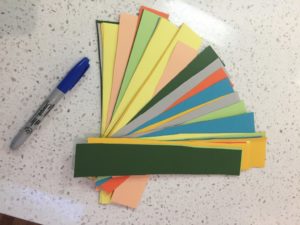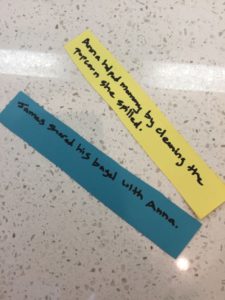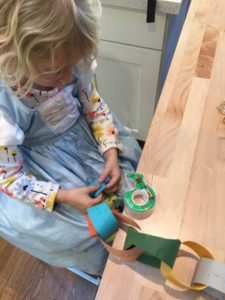I’m not ashamed to admit that one of my motivating factors in sending my daughter to preschool was that she’d get a chance to play with paint, Play-Doh and other messy things that I either don’t want to clean up at home or am not creative enough to think of, in the first place.
[easy-image-collage id=15080]
An added bonus, though, has been the clever, no-mess activities that her fabulous teachers pass along for us to try outside of school. This helps create consistency between my daughter’s home life and school life, reinforces what she’s learning, and expands my personal repertoire of parenting tricks.
Here’s one of my favorite ideas: The Kindness Chain. Each time my daughter or son does something kind for one another or someone else, they add a link to the chain. It’s similar to a behavior modification chart (i.e. a sticker chart) in that the intent is to encourage the behavior I want to see, but it’s oh-so-very different.
I’ve written about my experience with sticker charts before (actually, we used stamps). In the short term, my daughter was excited by the prospect of earning a new toy by acquiring stamps on her chart, but once the novelty wore off, the chart lost its effectiveness. Then, I started wielding it as sort of a veiled threat. “If you don’t brush your teeth, you won’t get a stamp!” She was only two-and-a-half at the time, and she still wasn’t buying it. The chart fizzled after a few weeks.
A kindness chain isn’t about modifying specific behaviors. It’s simply about creating awareness of the many daily opportunities we have to be good people. I haven’t promised my kids a reward if the chain grows to a certain length, and they’re still genuinely thrilled each time we add a link. They also like to review the things they’ve done to earn earlier links.
My three-and-a-half year old understands this concept much more than my two year old, but even he likes it. This is something he shares with his sister, which is exciting to him, and it’s never too early to prioritize the value of being a thoughtful, considerate, compassionate person. After all, research has shown that being kind is actually good for our health.
Here’s how to start your own kindness chain:
- Cut strips of construction paper and keep them somewhere handy. These are your links.

- When your child does something especially thoughtful, write it down on a link and connect it to the chain.

- It’s helpful to start the chain with your kids by writing down a few examples of things they’ve recently done to create the first few links of the chain.

The expectations for what earns a link are up to you, and kindness doesn’t have to be the only behavior that gets positive recognition, but the simpler it is, the easier it will be for your kids to understand.
- “James shared his cookie with Anna.”
- “Anna asked Mommy and Daddy if they had a nice day.”
- “Anna and James both helped clean up their toys.”
On the flip side, you don’t have to consistently add a link for every little thing that they do. Once they understand the baseline concept, raise the bar, so the chain maintains its novelty and fits more easily into your family routine.
We hang our kindness chain off a coat rack behind the back door, but if you can’t bear the thought of one more kid craft on the wall, try writing on small slips of paper and putting them in a jar. Seeing the jar fill up has a similar effect to watching a chain grow, but, I have to be honest, something about that chain really makes young kids excited.
My favorite part of the kindness chain is that my children’s individual actions contribute to one chain. They’re not in competition to see whose chain is longer. They’re seeing that their collective effort is important, what they do affects others, and they’re learning that good things happen (their chain grows) when they treat people well. Not every kid will be the smartest, the most athletic, popular or artistic, but they all can be kind.






















